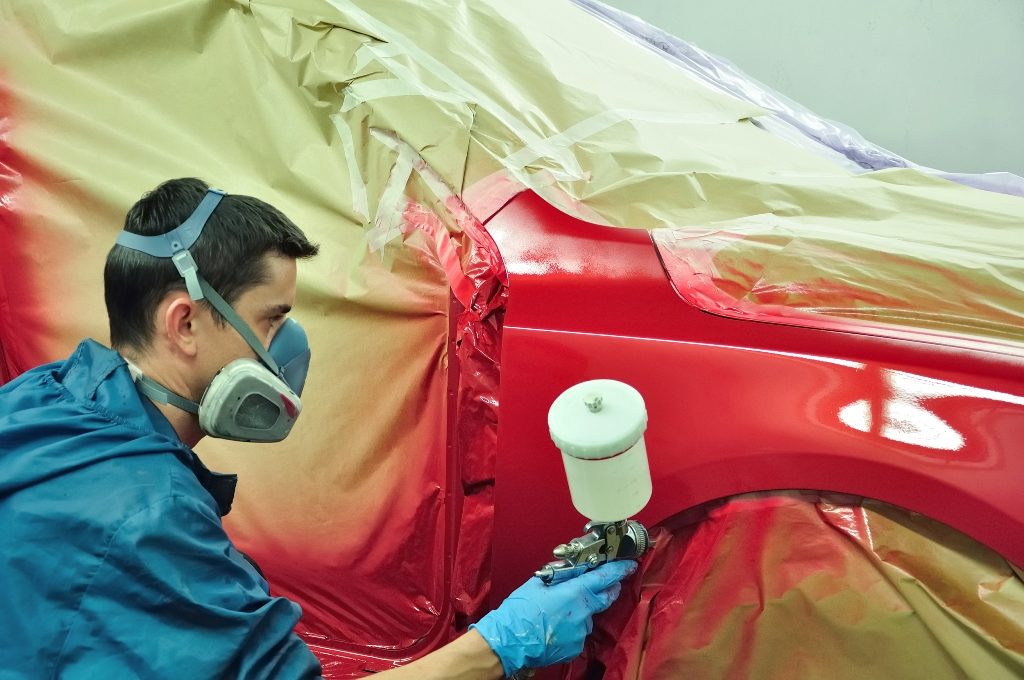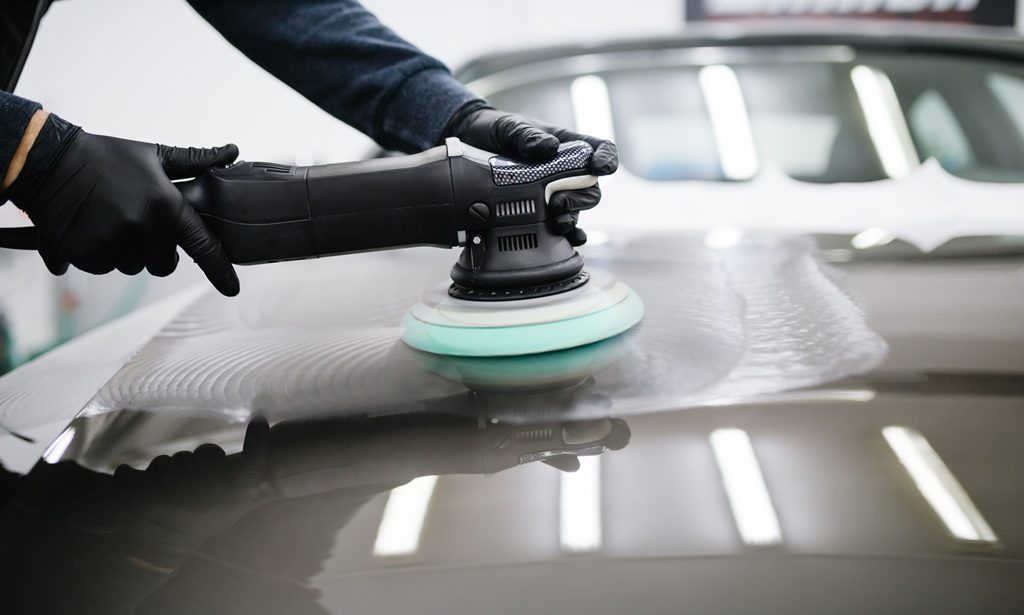Rust is the product of air and moisture on surfaces with iron. You can compare rust to a cavity in your tooth. Once it is present, it can eat away the remaining surface if not thoroughly removed. Your car is predominantly made of metal which is not spared from rust. Car manufacturers fight the effects of rust by painting your car and all its metal surfaces. As the paint grows older or is neglected it will begin to crack exposing the bare metal underneath it. Thankfully, we can help you remove the rust from your car without welding on a new piece of sheet metal. We’ve broken it down into three processes which will bring your car back from rust patches.
Before starting, assess that the rusted areas do not need a new panel or new sheet metal welded in. If the area affected has a hole larger than your fist, consider purchasing a new panel or bringing your car to a body shop.
Removing Rust
What you will need:
- Rubbing Alcohol
- Paper towels
- 80-grit sandpaper
- Small hammer
- Stainless steel mesh body patch
- Compressed air/ leaf blower
- 320-grit sandpaper

- Wash your car thoroughly and dry
- Wipe down the area you’ll be working on with rubbing alcohol. This removes wax and other oil buildup.
- Remove panels or trim which don’t need to be worked on. Examples of these are bumper, door handles, and other plastic trims.
- Sand the rusted area with 80-grit sandpaper making sure not to leave any rust on the surface. Remember that there are two sides to the sheet metal of your car. Check if the back side also has rust and sand away all the affected surfaces. You have to sand all the rust away or else this whole process will be useless, because the rust will just continue to spread. Sand at least an inch past the area to make sure all the rust was removed. You can use an angle grinder with a sandpaper attachment, or a Dremel with a sandpaper attachment instead of hand sanding. (Keep in mind that these tools are aggressive and can potentially damage the area. Don’t worry if there are small holes in the body work due to rust eating through the sheet metal.)
- Stop when all the rust has been sanded away, and the bare sheet metal is exposed.
- Take a hammer and lightly indent the area you are repairing. This creates space for the body filler so it does not create a “hump” over the area that is being worked on.
- Cut and bend the stainless steel mesh body patch to fit the hole created by the rust.
- Place the stainless steel mesh body patch behind the hole, in order to support the body filler.
- Clean the area by using a leaf blower or compressed air to blow away the sanding debris.
- Further clean the area with another application of rubbing alcohol.
- Mix your body filler and hardener on a non-absorbing/ non-porous surface.Be sure to get the proper ratio of hardener to body filler. Using the body filler spreader, press all the air out of the mixture while mixing it until the color of the body filler is uniform. Remember that body filler only has 5-minutes until it hardens.
- Use your body filler spreader to press the filler into the body and spread it across the area. Make sure that the filler is approximately leveled with the rest of the body panel.
- Leave filler to dry for 15 – 20-minutes.
- Sand down the body filler with 80-grit sandpaper to make it flush with the car’s body. Take note of the different creases and body lines on the car while sanding. Shape the area with body filler by sanding around the lines and creases.
- Once the body filler surface is flush, sand the area with 180-grit sandpaper to smoothen the surface. The surface between the body filler and the rest of the panel should only feel like a single piece of metal. There should not be a line where the body filler starts. If there is a ridge or bump, continue sanding the area until it feels like one panel.
- Apply a thin layer of glazing & spot putty on the body filler surface to fill in the little holes and imperfections. Leave on the surface for 15-minutes to completely dry.
- Sand down with 320-grit sandpaper making sure the surface is flush with the rest of the panel.
- Clean the area with compressed air or a leaf blower, and give the surface a thorough wipe down with rubbing alcohol.

Painting
What you will need:
- Paper
- Painters tape
- Rubbing alcohol
- Paper towels
- Compressed air/ leaf blower
- Rattle can of Primer
- Rattle can of Base coat (See owner’s manual for specific body color code)
- Rattle can of Clear coat
- 600-grit sandpaper
- Container of hot water
- Before painting, you’ll want to mask off areas which don’t need paint. To prevent harsh lines between the newly painted surface and the existing body panel, take a piece of paper and bend it half way. Do not fold it or crease it. Tape as many pieces of bent paper around the area to create a smooth transition between the newly painted surface and the existing panel.
- Shake the rattle can of primer thoroughly.
- Apply three even coats of primer allowing it to dry between coats. (Follow the instructions on the rattle can to get the best finish.)
- Sand the dry primer down with 600-grit sandpaper making sure not to press down too hard.
- Keep sanding until primer and the existing panel is flush and smooth to the touch.
- Wipe down the surface with rubbing alcohol to get rid of any contaminants.
- Mask off the area again in the same manner as step 1.
- Shake the rattle can of base coat thoroughly.
- Lightly apply the first base coat focusing on the body filler area.
- Wait till the first base coat is dry to a matte finish.
- Apply the second base coat making sure to give it a slightly thicker application.
- Wait till the second base coat is dry to a matte finish.
- Apply the third base coast making sure to give it a slightly thicker application than the previous.
- Wait till the third base coat is dry to a matte finish.
- While waiting for the third base coat to dry, submerge your rattle can of clear coat in a container of hot water. This heats it up and prevents orange peel.
- Shake the rattle can of clear coat thoroughly.
- Apply three coats of clear coat making sure to dry the surface between coats. Let clear coat dry for 48-hours.

Polishing
What you will need:
- Painters tape
- Sponge
- Sandpaper (1500-grit – 5000-grit)
- Liquid Polish
- Electric Polisher with wool polishing pad
- Microfiber towel
- Clean the area of the newly painted surface with soap and water.
- Tape off areas which you do not want to wet sand.
- Soak 1500-grit, 2000-grit, 3000-grit, and 5000-grit sandpaper in soapy water.
- Wrap the 1500-grit sandpaper around a sponge much like you would a sanding block.
- Spray the entire panel with soapy water. The more lubrication on the area the better.
- DO NOT sand in circular motions. Use a crosshatch pattern while sanding. Finish three passes over the area.
- Spray the area down with water and wipe clean.
- Repeat the process for the 2000-grist, 3000-grit, and 5000-grit sandpaper to get a uniform haze on the panel.
- Use a preferred polish and apply four dots on the wool polishing pad.
- Spread polish on the panel to prevent slinging the polish to other surfaces.
- Polish the panel using a low to medium speed setting on the electric polisher. Keep going till the liquid polish has dissipated.
- Wipe panel clean.
Note: This process can be done by hand but will take a lot of time and effort to buff out every little scuff made by the wet sanding process.
Rust can happen to a car as young as five years old. Protecting your car or truck is the first step to preventing rust from building. For cars and trucks in the “salt belt,” make sure to rinse the underside of your vehicle to remove the salty water. For those living by the sea, be sure to get a protective undercoating to prevent the salt carried by the wind to start rust. Simply waxing your car every six-months will protect your car from rusting. Keeping the paint healthy on your car will keep the bare sheet metal from being exposed. If you are involved in a fender-bender and some sheet metal is exposed, spray the exposed area with some clear coat till you can fix the damage.
Different Types of Rust on a Car
How hard it is to get rid of rust depends on the type of rust you’re dealing with. The three types of car rust are surface rust, scale rust, and penetrating rust.
Surface Rust
When small objects hit the car’s body at high speed, the damage can expose the steel beneath the paint surface and give rust room to develop. Fortunately, surface rust is the easiest type to remove, as it only affects the car’s top layer.
It’s best to take immediate action to prevent surface rust from spreading. Patch up the area with a coat of automotive primer, a coat or two of paint, and a quick buff.
Scale Rust
Surface rust that’s been neglected will eventually turn to scale rust.
Scale rust can create small holes in the affected area and make the paint surface around them “bubble.” It also corrodes the body panels and strips the paint of other parts, leaving the bare metal exposed.
This type of rust is damaging, so treating it requires more aggressive treatment. You’ll likely need to use a wire brush to scrub the corroded surface and rub the area with sandpaper before applying a primer, paint, and buff job.
Penetrating Rust
Lastly, penetrating rust is the most dangerous, as it’s the result of neglecting both surface and scale rust. At its worst, penetrating rust can compromise the structural integrity of your vehicle. Affected parts can form holes and fall to pieces.
Unfortunately, rust at this level requires you to seek professional assistance, as you’ll need to remove the affected car part and replace it with a new one.

What Causes Rust on A Car?
Regardless of the area, rust forms because of the same chemical reaction, specifically when iron, oxygen, and moisture come into contact.
This reaction is more common for cars, especially when they’re exposed to salt, acid rain, high humidity, and poor maintenance.
Salt
Oxidation happens when metal atoms lose electrons and produce ions. Adding salt, which contains ions, speeds up the rusting process by allowing electrons to flow readily from iron to oxygen.
Your car is more exposed to salt than you think.
For example, road salt, as the name suggests, contains salt to clear off snow that can get stuck on your car’s underbody. If not cleaned immediately, this will speed up the oxidation process, resulting in rust.
Living or driving near the ocean has a similar effect because the air also has a high salt content.
Acid Rain
Acid rain is a term used for precipitation with acidic components. Some examples include rain, snow, fog, hail, or dust.
The acidic components that make contact with your vehicle can negatively react with the paint and metal surfaces. This can lead to fading, chipping, peeling, and corrosion.
It gets worse when the acid material is left behind on the surface after the water evaporates. You can prevent acid rain damage by applying a layer of wax or sealant to your car’s surface.
High Humidity
While it doesn’t necessarily start the corroding process, high humidity does help accelerate it.
It’s even worse when you’re parked in an area that had road salt used recently. The combination of moisture and salt in the air creates a corrosive environment that leads to rust spots.
Besides rust, high humidity can also damage the engine once moisture gets in because the mechanical parts are more prone to rust while the rubber seals deteriorate quickly.
Poor Maintenance
You can prevent all corrosion from spreading by maintaining your car properly. Poor maintenance will not only cause rust, but it will also worsen surface rust. Rust is progressive and weakens iron and steel. As such, leaving it unattended will only cause it to spread.
As for maintenance, follow a schedule to prevent corrosion and check on crucial components. Have your car maintained at least once or twice a year. If you’re unsure what to look for, it’s best to consult with a professional.
Any information provided on this Website is for informational purposes only and is not intended to replace consultation with a professional mechanic. The accuracy and timeliness of the information may change from the time of publication.



















